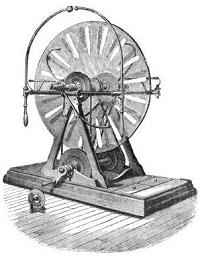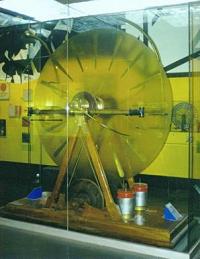The largest Wimshurst machine ever built
 |
 |
 |
 |
What is probably the largest classical Wimshurst machine was constructed by J. Wimshurst in 1884. It had varnished glass disks with 7" (2.13 m) of diameter, 3/8" (9.5 mm) thick. In good conditions, it could produce sparks 14" (35.5 cm) long, and was designed to produce 30" (76 cm) sparks with suitable Leyden jars (apparently, it reached only 22"). It was first described in Engineering, January 16, 1885, page 60.
The machine was in the Science Museum of South Kensington,
England, until 1931, when it was transferred to the Museum of
Science and Industry, in Chicago, USA. By that time the plates
were broken, and were replaced by new ones. One of the new disks
broke again in 1941. It was repaired, but since then the machine
was only rarely run. A disk broke again in 1991. By 2009-2010 it
was restored
again.
The machine, from the back side. Note
that there are cranks on both sides, as seen in the
old drawing.
A crank. Another view.
One of the supports that hold the main
axle, charge collectors, and the neutralizers.
Another view of the support structure.
The charge collectors. Detail of the combs. Note that they are not directly
opposite,
what should increase the output current, but the machine is
incorrectly
assembled. The correct configuration is shown in the drawing, that
shows the collectors that are out of the center plane moved in the
direction of the nearest neutralizers, as suggested by Schaffers [26].
A neutralizer brush.
The broken disk.
Leyden jars.
Recent views of the machine, restored: Front,
back. There is still something
strange
with the positions of the charge collectors.
After this machine, disk machines were rarely built with very
large disks, as it was considered more practical to make multiple
machines with smaller size, interconnected in parallel for larger
current. A large machine is the only solution for high voltage
output, what appears to have been the objective of this machine,
with just 16 small sectors per disk.
A machine a bit larger than this, but with modern structure, can
be
seen at the Technorama
science center, in Winterthur, Switzerland.
The largest multiple Wimshurst machine was the machine built by
Archibald Campbell, Lord Blythswood, for his laboratory in
Renfrew, Scotland, by 1892. The machine had 160 disks (some
sources say 128) with 3 feet of diameter and 16 sectors, powered
by a 1.5 hp electric motor. It was used in experiments about
X-rays, and was the power source in a a curious experiment that
apparently produced X-ray images without vacuum, before their
discovery by Roentgen in 1895.
Thanks to Mark S. Rzeszotarski for most of the photos, to visitors that posted online [1][2] the recent pictures, and to the MSI staff for additional informations.
Created: 15 August 1999
Last update: 17 July 2011
By Antonio Carlos M. de Queiroz
Return to Electrostatic Machines.